ITALY
TECHNOLOGY DEMONSTRATION
OPEN SEA TEST SITES
|
The Natural Ocean Engineering Laboratory (NOEL) of UNIRC provides a unique testing infrastructure in the marine environment, where field tests can take advantage of the dedicated sensors and data acquisition centre, and be carried out with the support and assistance of specialized personnel |
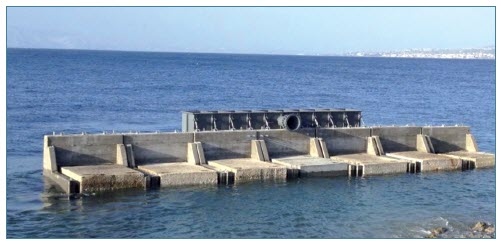 The NOEL at Reggio Calabria |
OPERATIONAL PROJECTS
In Italy there is an increasing interest in the exploitation of wave and tidal energy converters. In particular, wave energy converters (WECs) integrated into conventional breakwaters have gained more and more interest among the port managers, as they offer the opportunity of energy self-sufficiency for the infrastructures in conjunction with a limited increase in costs and with ease of maintenance.
WAVE CONVERTERS
REWEC3
The Università Mediterranea di Reggio Calabria has been developing the REsonant Wave Energy Converter (REWEC3 – at present TRL 7), which is a particular type of Oscillating Water Column (OWC) incorporated into a traditional vertical breakwater of monolithic reinforced concrete structure type. This activity is being carried out in cooperation with Wavenergy.it, an academic Spin-Off of the Mediterranea University. This device is composed of a chamber containing a water column in its lower part and an air pocket in its upper part. The air pocket is connected to the atmosphere via a small duct hosting a self-rectifying turbine. In addition, a REWEC3 also includes a small vertical U-shaped duct for connecting the water column to the open sea. The first full scale prototype is under construction in the port of Civitavecchia (Rome, Italy), as the Port Authority of Civitavecchia has recently decided to upgrade its infrastructure and adopted the REWEC3 technology for the realization of 17 new caisson breakwaters. Each REWEC3 caisson is 33.94 m long and includes 6-8 independent absorbing chambers. The total length of REWEC3 caissons is 578 m. A first Wells turbine of 20 kW, without any optimization, has been installed, while the total installed power will be 2.5 MW.
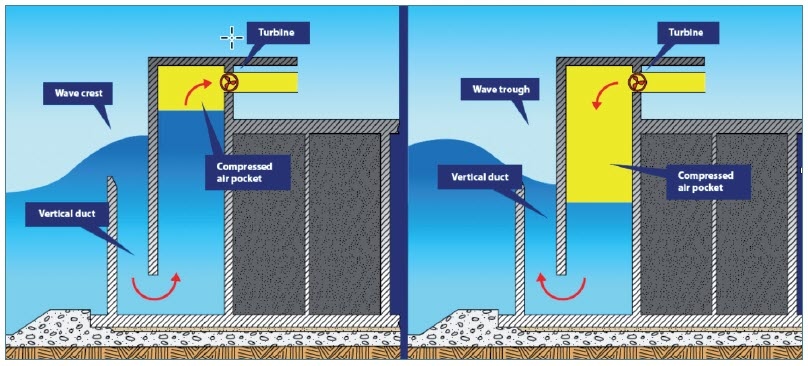
Scheme of a REWEC3
OBREC (Overtopping Breakwater for Energy Conversion)
The Università degli studi della Campania “Luigi Vanvitelli” has developed a device denominated OBREC (Overtopping Breakwater for Energy Conversion), embedded into a breakwater and based on the wave overtopping process. The device consists of a rubble mound breakwater with a frontal reservoir designed to capture the wave overtopping a sloping ramp in order to convert wave energy into potential energy. Water stored in the reservoir produces energy by flowing through low head hydraulic turbines. A small scale (1:30) prototype of the OBREC was tested at Aalborg University (Denmark) during two experimental test campaigns in 2012 and 2014. A full scale, 6 m long prototype was installed in the port of Naples in 2015, along the San Vincenzo rubble mound breakwater, where sea depth is about 25 m and available wave power is estimated to be around 2.5 kW/m. The overall performance of the device is being monitored.
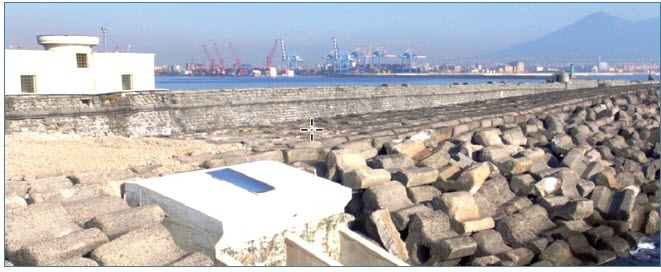
Breakwater equipped with the OBREC prototype in the port of Naples
SWEC (Inertial Sea Wave Energy Converter)
The Politecnico di Torino developed ISWEC (Inertial Sea Wave Energy Converter, TRL 7), a point absorber wave converter suitable for mild climate seas such as the Mediterranean. It is based on the gyroscopic technology already used in marine applications for roll stabilization, except that the direction of energy transfer is reversed, with the gyroscopic torque induced by the incoming waves being exploited by the electrical PTO. Research activities have started 10 years ago and led to the development of the technology industrialized by Wave for Energy, a spin-off of the Politecnico di Torino. In August 2016, the first full scale ISWEC prototype, with a nominal power of 100 kW, was moored 800 m from the coast of Pantelleria.
|
PEWEC (Pendulum Wave Energy Converter) A 1:12 prototype has been tested in the towing tank managed at CNR-INSEAN in Rome. Among the converters developed by 40SouthEnergy, the H24-50 kW was the first machine to reach commercial stage. The H24-50 kW is a small device, with a guiding member which sits on the sea floor or on a small support structure (depending on water depth and on tidal range), and a moving member above it, which moves under the action of waves or tides. H24 was first deployed off the coast of Marina di Pisa, Italy, and is operated and managed by Enel Green Power. |
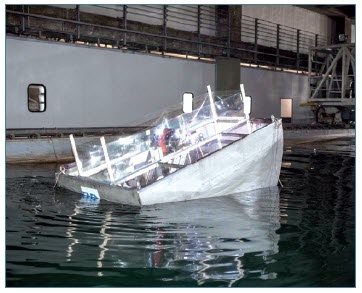 The PEWEC prototype at INSEAN |
|
|
WAVESAX This device has been conceived for its integration in coastal structures (e.g. harbours and ports). It consists of a vertical pipe in which water moves upward and downward, following the wave motion. Inside the pipe, a hydraulic bi-directional turbine is positioned. Laboratory test studies have been performed on a scale model (1:20) in the ocean wave basin of the HMRC - Hydraulic Marine Research Centre (Cork, Ireland). A second 1:5 scale prototype has been tested at the ECN Hydrodynamic and Ocean Engineering Tank (Nantes, France), in order to study different rotor configurations under regular and irregular wave conditions, while the facilities provided by CNR-INSEAN permitted the assessment of device performance for different turbine configurations and control strategies. |
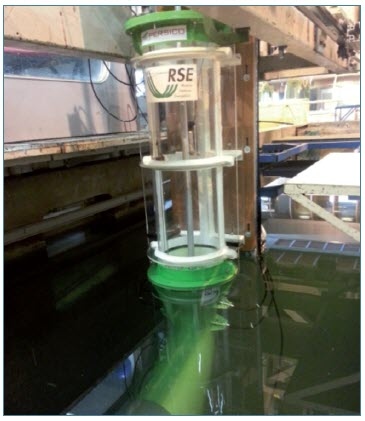 The WAVESAX 1:5 scale prototype |
GEL system
Seapower s.c.r.l. (a consortium between private companies and the Department of Engineering of the University of Naples “Federico II”), in collaboration with Umbra Group, developed the GEL system (TRL 5), a wave energy converter designed to be installed near the coast or in shallow waters. The device consists of a floating body linked to a fixed frame that is left free to oscillate around a horizontal axis under the action of waves. The permanent magnet electric generator, integrated in the Power Take-Off (PTO) actuator/generator, allows the transformation of linear motion induced by waves into rotary motion of the generator rotor. A 1:5 scale and a full scale prototype have been tested in the wave tank located at the Department of Industrial Engineering (DII) of the University of Naples “Federico II”. It has reached TRL 5 and it is ready for testing in real sea conditions.
TIDAL TURBINES
|
KOBOLD turbine A platform equipped with a Kobold turbine of the diameter of 6 m with three blades with a span of 5 m, built by the Ponte di Archimede Company, was installed in the Strait of Messina in the year 2000 and is still in operation. The nominal power output is 30 kW and the device is connected to the distribution grid. |
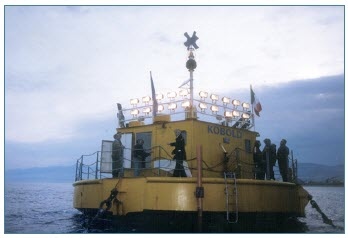 The Kobold installation |
|
|
GEM device A full scale prototype of 300 kW will be installed in the Strait of Messina. |
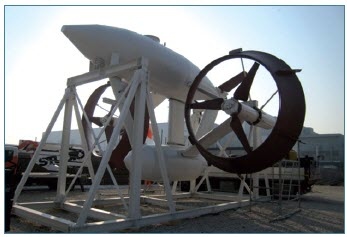 The GEM device |



